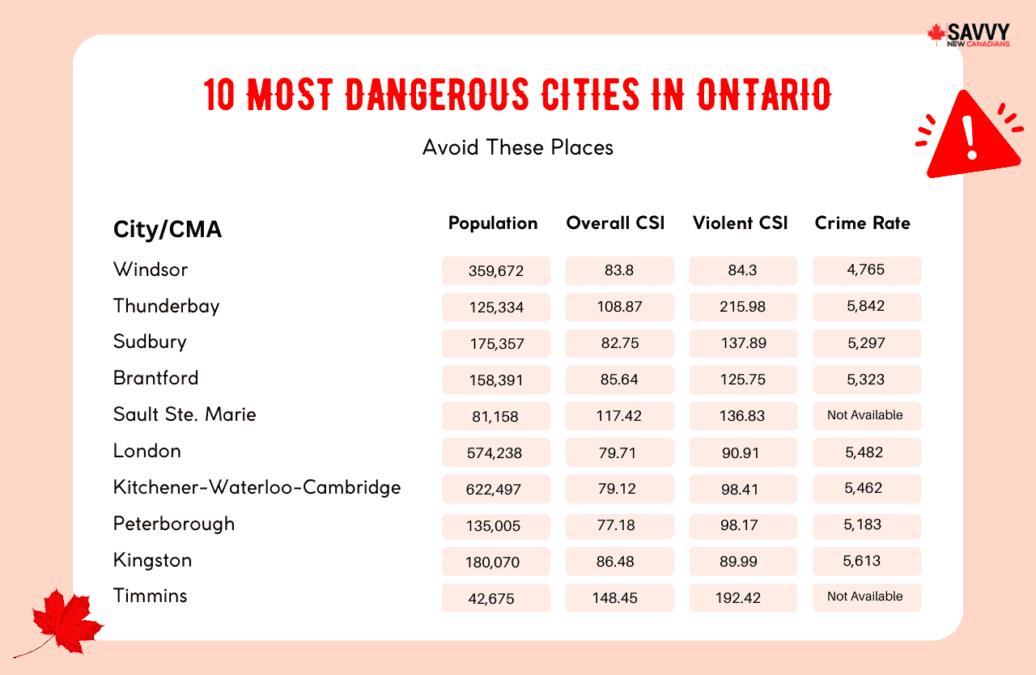Canada is one of the safest places in the world. Despite that, there are areas you might want to avoid. Among them are a few places in the city of Ontario.
The province has its fair share of crimes, with some areas having more dismal statistics than others. In this post, I will enumerate the top 10 worst places to live in Ontario and why you should avoid them.
Key Takeaways
- Some of the most dangerous cities in Ontario include Windsor, Thunder Bay, Sudbury, Brantford, Sault Ste. Marie, London, Kitchener-Waterloo-Cambridge, Peterborough, Kingston and Timmins.
- These cities have some of the highest CSIs and crime rates in Ontario, making them dangerous places to live in.
- Two chief factors contributing to high crime rates in a city are poverty and unemployment.
Worst Places to Live in Ontario
Below is a list of the worst cities to live in Ontario based on the Crime Severity Index (CSI), which monitors the severity level of crimes reported to the police. The index measures the general seriousness of crimes reported from year to year.
For comparison purposes, Canada’s crime rate for 2022 was 5,668, while its homicide rate was 2.25%. Its Overall CSI was 78.1, up 4% in 2022, which increased for the second consecutive year. The population in Canada in 2022 was 38,929,902.
Ontario’s CSI for 2022 was 58.5 (up 4%), while its Violent CSI was 77.7 (up 6.7%). The police-reported crime rate per 100,000 population is 4,151 (a 7.0% increase). The province’s estimated population during the previous year was 15,145,000.
Population estimates for 2022 (by Census Metropolitan Area (CMA)), homicide rates (per 100,000 population) and crime rates (based on 100,000 population) were all taken from Statistics Canada 2022 data.

1. Windsor
- Population: 359,672
- Overall CSI: 83.8
- Violent CSI: 84.3
- Crime rate: 4,765
One of the most favoured cities in the country, Windsor has been the automotive capital of Canada since the early 1900s, when the first Ford auto plant opened.
While the city’s Overall CSI in 2022 of 83.8 decreased (from 98.01 in 2021), it is higher than the national average. Armed robbery, breaking and entering, assault and drug-related crimes are rampant in the city.
The poverty rate here is 10.8%, resulting in Windsor earning the regional poverty capital moniker. The unemployment rate also rose to 5.8% in August 2023, up 0.2% from the previous month.
2. Thunder Bay
- Population: 125,334
- Overall CSI: 108.87
- Violent CSI: 215.98
- Crime rate: 5,842
Thunder Bay is a populous municipality in northwestern Ontario. Also called Lakehead, it is located on Lake Superior and is described as the seat of Thunder Bay District in the province.
In 2022, Thunder Bay had an Overall CSI of 108.9 (from 108.3 in 2021) and a Violent CSI of 216.0 (from 180.21 in 2021) — among the highest in Canada. Its crime rate is also higher than the national average.
The city’s homicide rates increased during the previous year, rising to 12.05% from 4.82% in 2021. The number of homicide victims rose to 15 in 2022 from 6 in 2021.
Authorities cited gang activity and illicit drug trade as the main drivers of the city’s homicide rates during the previous year.
Poverty in the city continues to be an issue, while the unemployment rate in Thunder Bay rose 0.4% to 4.6% in August 2023.
Nearly 15% of the Thunder Bay population earns less than $24,000 annually. In 2019, more than 3% of the population moved into poverty.
3. Sudbury
- Population: 175,357
- Overall CSI: 82.75
- Violent CSI: 137.89
- Crime rate: 5,297
Sudbury is the largest city in Northern Ontario and the second-largest municipality in Canada. With its mines, mills, smelters and refinery, it is known as the mining capital of Canada.
The city is one of the most affordable places to live in Canada, but violent crime rates here are significantly high. Authorities reported a 64% increase in violent crimes in the last year.
While the Overall CSI in Sudbury in 2022 dipped to 82.8 from 85.04 in 2021, its Violent CSI was at a high of 137.9 from 129.09 in 2021.
The homicide rate in 2022 rose to 5.83% from 3.55% in the previous year. The number of homicide victims increased to 10 in 2022 from 6 in 2021.
The major drivers for the rise are homicides, sex crimes, child pornography cases and firearm offences.
The city is also experiencing increased homelessness due to a lack of affordable housing. A 2020 report revealed that 12.8% of Sudbury’s population live in poverty.
As for the unemployment rate, it has dipped to 4.5% as of August 2023, a decrease of 0.2% from the previous month.
4. Brantford
- Population: 158,391
- Overall CSI: 85.64
- Violent CSI: 125.75
- Crime rate: 5,323
Brantford is a city in southern Ontario known as the Telephone City due to its famous resident, Alexander Graham Bell.
While Brantford was named as one of the safest cities in the country with a somewhat moderate Overall CSI of 85.6, the city had a significantly high Violent CSI of 125.8 in 2022.
The city’s homicide rate last year increased to 4.38% from 3.20% in 2021. The number of victims for the same period rose to 7 from 5.
Brantford police cited an increase in murders and attempted murders in 2022. Statistics Canada figures also reveal that in 2021, the city had the highest per-capita homicide rate in Ontario.
The unemployment rate in Brantford increased by 0.6% from the previous month to 4.8% as of August 2023.
5. Sault Ste. Marie
- Population: 81,158
- Overall CSI: 117.42
- Violent CSI: 136.83
Sault Ste. Marie is the third largest city in Northern Ontario. It is popular with tourists for different reasons, such as its proximity to the Great Lakes of Canada and its sandy beaches.
Nevertheless, it is known as one of the most dangerous cities in the country based on the Canada Crime Index. The city had an Overall CSI of 117.4 and a Violent CSI of 136.8, which are both very high.
The most common crimes in Sault Ste. Marie are aggravated assault, theft and drug-related crimes.
The city’s unemployment rate as of August 2023 was 5.7%, up 0.1% from the previous month.
Poverty remains an issue in this city. A 2022 paper stated that around 11,000 people struggle with poverty. In 2016, Statistics Canada figures showed that 15.3% of the population lived below the poverty line.
6. London
- Population: 574,238
- Overall CSI: 79.71
- Violent CSI: 90.91
- Crime rate: 5,482
London is a major city in southwestern Ontario that is among the most populated in the province. Known as the Forest City, it is a hub for medical research, technology, manufacturing and higher education.
The city is also regarded as one of the most dangerous places in Ontario. Despite that, London’s crime rate has decreased in the last year due to a drop in criminal offences.
The city had a Violent CSI in 2022 of 90.9, which is higher than the national average. The most commonly reported crimes in London are homicide, assault and property crimes.
The rate of unemployment in London increased by 0.6%, climbing to 5.6% as of August 2023.
Poverty is also one of the persistent problems in the city. Statistics Canada 2021 data showed that the poverty rate here was 10.6%, the second-highest among the region’s major cities. In the 2016 Statistics Canada census, 17.0% of people in the city were living below the poverty line.
7. Kitchener-Waterloo-Cambridge
- Population: 622,497
- Overall CSI: 79.12
- Violent CSI: 98.41
- Crime rate: 5,462
The Tri-Cities of Kitchener, Waterloo and Cambridge in southern Ontario are a hodgepodge of over half a million people. It is characterized as Canada’s Silicon Valley due to a high concentration of IT companies.
It is also considered one of the most dangerous places in the province, with the region reporting a significant rise in violent crimes in 2022.
Canada Crime Index data showed a high Violent CSI of 98.4 (Kitchener). The violent crimes reported include homicide, assault, robbery and cybercrime.
The homicide rates per 100,000 population rose from 0.33% in 2021 to 1.10% in 2022. The number of homicide victims rose from 2 to 7 in the same period.
As of August 2023, the region’s unemployment rate slid to 5.6% from 5.9% in the previous month.
8. Peterborough
- Population: 135,005
- Overall CSI: 77.18
- Violent CSI: 98.17
- Crime rate: 5,183
Peterborough, a city in southeastern Ontario, is a short drive from Montreal, Ottawa and Toronto. It is a major manufacturing centre known for being Canada’s canoe-building capital.
The city, which had a Violent CSI of 98.2 in the Canada Crime Index, saw a 13.4% increase in reported crimes in the previous year.
Its homicide rate increased in 2022 to 2.29% from 1.55% in 2021. There were 3 homicide victims last year, up from 2 in 2021.
Reported criminal activities on the rise last year were robberies, arson, fraud, thefts and breaking and entering.
Still, the city’s unemployment rate in August 2023 remarkably decreased, slipping to 4.0% from 6.8% in July.
9. Kingston
- Population: 180,070
- Overall CSI: 86.48
- Violent CSI: 89.99
- Crime rate: 5,613
The city of Kingston, located on the northeastern end of Lake Ontario, is one of the most affordable places in the province. It has also been ranked as one of the most dangerous cities in Ontario.
With an Overall CSI of 86.5 and a Violent CSI of 90.0, Kingston has had its share of violent crimes, including murder, assault, robberies, theft, fraud, and break-ins.
The homicide rate in the city rose to 4.50% (8 homicide victims) last year from 2.29% (4 victims) in 2021.
The city of Kingston had the highest rate of low income individuals in 2020, with 10.1% of the Kingston CMA population having an income below LIM-AT (e Low-Income Measure After-Tax).
As of August 2023, Kingston had an unemployment rate of 3.9%, an increase of 0.3% from the previous month.
10. Timmins
- Population: 42,675
- Overall CSI: 148.45
- Violent CSI: 192.42
Timmins is the fourth largest city in northeastern Ontario. It is the largest gold producer and is recognized globally as one of the richest gold regions in the world.
The city, which can be considered as one of the most dangerous cities in Canada, is ranked highly in the Canada Crime Index for 2022, with Overall and Violent CSI rates of 148.5 and 192.4, respectively.
Data from Timmins Police showed 2,587 police calls for service in 2022 for property crime, up from 2,221 in 2021.
Social disorder had the most calls in 2022 at 8,649 (up from 8,035 in 2021). Calls for violent crimes decreased to 997 from 1,044 in 2021.
Summary
| City/CMA | Population | Overall CSI | Violent CSI | Crime Rate |
| Windsor | 359,672 | 83.8 | 84.3 | 4,765 |
| Thunder Bay | 125,334 | 108.87 | 215.98 | 5,842 |
| Sudbury | 175,357 | 82.75 | 137.89 | 5,297 |
| Brantford | 158,391 | 85.64 | 125.75 | 5,323 |
| Sault Ste. Marie | 81,158 | 117.42 | 136.83 | Not available |
| London | 574,238 | 79.71 | 90.91 | 5,482 |
| Kitchener-Waterloo-Cambridge | 622,497 | 79.12 | 98.41 | 5,462 |
| Peterborough | 135,005 | 77.18 | 98.17 | 5,183 |
| Kingston | 180,070 | 86.48 | 89.99 | 5,613 |
| Timmins | 42,675 | 148.45 | 192.42 | Not available |
What Makes These the Worst Cities in Ontario?
High crime rates and CSI numbers (generally above 88) are two factors that make these cities some of the most dangerous cities in Canada and in Ontario.
A city with a high crime rate is considered dangerous, especially if the crimes committed are violent, such as homicide, assault and robbery.
Various factors contribute to crime rates in a city, including poverty, unemployment and gang activity.
As of August 2023, the unemployment rate in Ontario is 5.9%, slightly above the national average of 5.5%.
What Are the Best Cities to Live in Ontario?
Below are the best cities to live in Ontario based on the 2022 Overall CSI. All are far below the national average.
| City/CMA | Population | 2022 Overall CSI | 2022 Violent CSI | 2022 Crime rate | 2022 Homicide Rates* |
| Toronto | 6,685,621 | 51.9 | 91.7 | 3,531 | 2.06 |
| Ottawa | 1,498,610 | 54.1 | 65.3 | 4,019 | 1.32 |
| Barrie | 228,979 | 56.7 | 70.5 | 3,691 | 1.47 |
| Guelph | 172,400 | 60.6 | 67.3 | 4,714 | 1.33 |
| Hamilton | 821,839 | 65.0 | 84.3 | 4,101 | 1.26 |
| Canada | 38,929,902 | 78.1 | 97.7 | 5,668 | 2.25 |
| Ontario | 15,145,000 | 58.5 | 77.7 | 4,151 | – |
FAQs
Ontario, with a CSI of 58.5%, has the lowest CSI in all provinces of Canada. Northwest Territories has the highest CSI (436.8). As for the CMAs, the two cities with the highest crime rates are Kelowna (10,532) and Lethbridge (9,358).
In its Safe Cities Index 2021, The Economist ranked Toronto as the second safest city with a score of 82.2, next to Copenhagen with 82.4. This indicates that Toronto is safer than the USA. The US city ranked highest on the list is New York, at 11th place with a score of 77.8.
Compared to the national average of 78.1, Oshawa’s 2022 Overall CSI of 44.11 is very low as well as its Violent CSI of 60. The number of homicide victims in Oshawa dropped from 10 in 2021 to 3 in 2022. The homicide rate also went down in the previous year.
According to the Crime Rate data from Statistics Canada, the CMA with the highest crime rate was Kelowna, BC, with 10,532. On the Canadian Crime Index, Kelowna’s Overall CSI was 150.7, while its Violent CSI was 123.3. Among the cities with a minimum population of 25,000, Prince Albert (population: 36,768) in Saskatchewan had the highest Overall CSI of 302.2, while its Violent CSI was 487.4.
Related:



